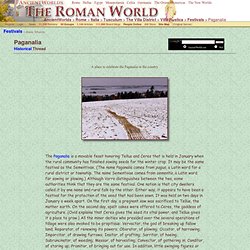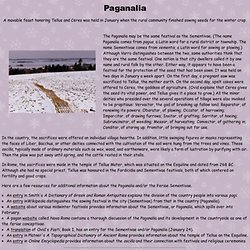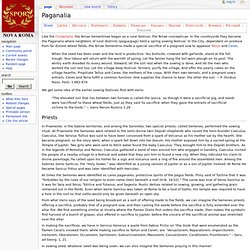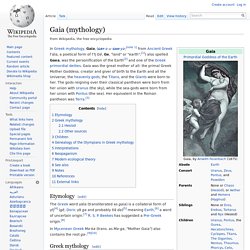

Paganalia. Festivals (- threads, 919 posts) ...

A place to celebrate the Paganalia in the country Paganalia Puzzle Created by: Paganalia. Paganalia A movable feast honoring Tellus and Ceres was held in January when the rural community finished sowing seeds for the winter crop.

Paganalia. From NovaRoma Home| Latíné | Deutsch | Esperanto | Español | Français | Italiano | Magyar | Português | Română | Русский | English Like the Compitalia, the feriae Sementinae began as a rural festival, the feriae conceptivae.

In the countryside they became the Paganalia where neighbors of rural districts (pagus/pagi) held a spring sowing festival. In the City, dependent on produce from far distant wheat fields, the feriae Sementina made a special sacrifice of a pregnant sow to appease Tellus and Ceres. When the seed has been sown and the land is productive. We get some idea of the earlier sowing festivals first with Varro: "The elevated soil that lies between two furrows is called the 'porca,' as though it were a sacrificial pig, and seeds were 'sacrificed' to these wheat fields, just as they said 'to sacrifice' when they gave the entrails of sacrificial victims to the Gods. " ~ Varro Rerum Rustica 1.29 Priests Hoc rapum mihi vico sereo. Date. Sementivae. Sementivae, also known as Feriae Sementivae or Sementina dies (in the country called Paganalia), was a Roman festival of sowing.

It was a type of feriae conceptivae [or conceptae]. These free days were held every year, but not on certain or fixed days, the time being every year appointed by the magistrates or priests (quotannis a magistratibus vel sacerdotibus concipiuntur,[1] Notes[edit] Jump up ^ Macrobius l. c.; Varro, On the Latin Language in 25 Books, vi. 25, etc.; Festus s. v.).Jump up ^ Varro On the Latin Language in 25 Books, vi. 26, de Re Rustica, i. 2, init.; Ovid, On the Roman Calendar, i. 658, etc.)Jump up ^ Merkel, Ovid, On the Roman Calendar, p. clv.
References[edit] This entry incorporates public domain text originally from (eds. Fordicidia. In ancient Roman religion , the was a festival of fertility, held April 15, that pertained to farming and animal husbandry . It involved the sacrifice of a pregnant cow to Tellus , or Mother Earth, in proximity to the festival of Ceres ( Cerealia ) on April 19. [ 1 ] On the Roman religious calendar , the month of April was in general preoccupied with deities who were female or ambiguous in gender, opening with the Feast of Venus on the Kalends . [ 2 ] Several other festivals pertaining to farm life were held in April: the Parilia , or feast of shepherds, on April 21; the Robigalia on April 25, to protect crops from blight; [ 3 ] and the Vinalia , or one of the two wine festivals on the calendar, [ 4 ] at the end of the month.
Of these, the Fordicidia and Robigalia are likely to have been of greatest antiquity. . [ edit ] Sacrifice and ritual. Terra (mythology) The word tellus, telluris is also a Latin common noun for "land, territory; earth," as is terra, "earth, ground".

In literary uses, particularly in poetry, it may be ambiguous as to whether the goddess, a personification, or the common noun is meant. This article preserves the usage of the ancient sources regarding Tellus or Terra. Dedicatory inscription to Terra Mater fulfilling a vow (votum), 1st century AD The two words terra and tellus are thought to derive from the formulaic phrase tersa tellus, meaning "dry land". [citation needed] The etymology of tellus is uncertain; it is perhaps related to Sanskrit talam, "plain ground The 4th-century AD Latin commentator Servius distinguishes between tellus and terra in usage. Varro identifies Terra Mater with Ceres: The Temple of Tellus was the most prominent landmark of the Carinae,[14] a fashionable neighborhood on the Oppian Hill.[15] It was near homes (domūs) belonging to Pompey[16] and to the Cicero family.[17] Tellumo is identified by St.
Gaia (mythology) The Greek word γαῖα (transliterated as gaia) is a collateral form of γῆ[4] (gē, Doric γᾶ ga and probably δᾶ da)[5] meaning Earth,[6] a word of uncertain origin.[7] R.

S. P. Beekes has suggested a Pre-Greek origin.[8] In Mycenean Greek Ma-ka (trans. as Ma-ga, "Mother Gaia") also contains the root ga-.[9][10] According to Hesiod, Gaia conceived further offspring with Uranus, first the giant one-eyed Cyclopes: Brontes ("Thunder"), Steropes ("Lightning") and Arges ("Bright");[16] then the Hecatonchires: Cottus, Briareos and Gyges, each with a hundred arms and fifty heads.[17] As each of the Cyclopes and Hecatonchires were born, Uranus hid them in a secret place within Gaia, causing her great pain. Because Cronus had learned from Gaia and Uranus, that he was destined to be overthrown by his own child, Cronus swallowed each of the children born to him by his Titan sister Rhea. With Gaia's advice[21] Zeus defeated the Titans. In classical art Gaia was represented in one of two ways.